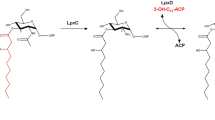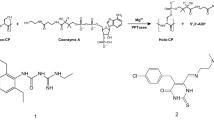Abstract
Sulfonamides were amongst the first clinically useful antibacterial agents to be discovered. The identification of sulfanilamide as the active component of the dye Prontosil rubrum led to the synthesis of clinically useful analogues. Today sulf amethoxazole (in combination with trimethoprim), is used to treat urinary tract infections caused by bacteria such as Escherichia coli and is also a first-line treatment for pneumonia caused by the fungus Pneumocystis carinii, a common condition in AIDS patients. The site of action is the de novo f olate biosynthesis enzyme dihydropteroate synthase (DHPS) where sulfonamides act as analogues of one of the substrates, para-aminobenzoic acid (pABA). We report here the crystal structure of E.coli DHPS at 2.0 Å resolution refined to an R-factor of 0.185. The single domain of 282 residues forms an eight-stranded α/β-barrel. The 7,8-dihydropterin pyrophosphate (DHPPP) substrate binds in a deep cleft in the barrel, whilst sulfanilamide binds closer to the surface. The DHPPP ligand site is highly conserved amongst prokaryotic and eukaryotic DHPSs.
This is a preview of subscription content, access via your institution
Access options
Subscribe to this journal
Receive 12 print issues and online access
$189.00 per year
only $15.75 per issue
Buy this article
- Purchase on Springer Link
- Instant access to full article PDF
Prices may be subject to local taxes which are calculated during checkout
Similar content being viewed by others
References
Blakley, R.L. & Benkovic, S.J. (eds.) in Folates and Pterins, 1, Chemistry and Biochemistry of Folates. John Wiley & Sons. Inc., NY.
Richey, D.P. & Brown, G.M. The Biosynthesis of Folic Acid. IX. Purification and properties of the enzymes required for the formation of dihydropteroic acid. J. Biol. Chem. 244, 1582–1592 (1969).
Shiota, T., Baugh, C.M., Jackson, R., & Dillard, R. The enzymatic synthesis of hydroxymethyldihydropteridine pyrophosphate and dihydrofolate. Biochemistry 8, 5022–5028 (1969).
Bock, L.B., Miller, G.H., Schaper, K.-J., & Seydel, J.K., Sulfonamide structure-activity relationships in a cell-free system. 2. Proof for the formation of a sulfonamide-containing folate analog. J. Med. Chem. 17, 23–28 (1974).
Brown, G.M. The biosynthesis of folic acid. II. Inhibition by sulfonamides. J. Biol. Chem. 237, 536–540 (1962).
Shiota, T., Disraely, M.N. & McCann, M.P. The enzymatic synthesisof folate-like compounds from hydroxymethyldihydropteridine pyrophosphate. J. Biol. Chem. 239, 2259–2266 (1964).
Woods, D.D. The relation of p-aminobenzoic acid to the mechanism of the action of sulphanilamide. Br. J. Exp. Pathol. 21, 74–90 (1940).
Then, R., & Angehrn, P., Sulfonamide-induced thymineless death in Escherichia coli. J. Gen. Microbiol. 76, 255–263 (1973).
Roland, S., Ferone, R., Harvey, R.J., Styles, V.L. & Morrison, R.W. The characteristics and significance of sulfonamides as substrates for Escherichia coli dihydropteroate synthase. J. Biol. Chem. 254, 10337–10345 (1979).
Hitchings, G.H. Biochemical basis for the antimicrobial activity of Septrin. Trimethoprim/Sulfamethoxazole in Bacterial Infections (eds Bernstein, L.S. & Salter, A.J.) 7–29 (Churchill Livingstone, London, 1973)
Northey, E.H. The sulfonamides and allied compounds. American Chemical Society monograph. (Reinhold Publishing Co., New York, NY, 1948).
Mobley, H.L., Island, M.D. & Massad, G. Virulence determinants of uropathogenic Escherichia coli and proteus mirabilis. Kidney Int. S47, S129–36 (1994)
Kovacs, J.A. et al. & Masur, H. Pneumocystis carinii pneumonia: A comparison between patients with the acquired immunodeficiency syndrome and patients with other immunodeficiencies. Annl. Int. Med. 100, 663–671 (1984)
Lopez, P., Espinosa, M., Greenberg, B. & Lacks, S.A. Sulfonamide resistance in Streptococcus pneumoniae: DNA sequence of the gene encoding dihydropteroate synthase and characterization of the enzyme. J. Bacteriol. 169, 4320–4326 (1987).
Sundstrvm, L., Radstrvm, P., Swedberg, G. & Skvld, O. Site-specific recombination promotes linkage between trimethoprim- and Sulfonamide resistance genes. Sequence characterization of dhfrV and sull and a recombination active locus of Tn21. Mol. Gen. Genet. 213, 191–201 (1988).
Radstrvm, P. & Swedberg, G. RSF1010 and a conjugative plasmid contain sulll, one of two known genes for plasmid-borne Sulfonamide resistance dihydropteroate Synthase.Antimicrob. Agents Chemother. 32, 1684–1692 (1988).
Slock, J., Stahly, D.P., Han, C.-Y., Six, E.W. & Crawford, I.P. An apparent bacillus subtilis folic acid biosynthetic operon containing pab, an amphibolic trpG gene, a third gene required for synthesis of para-aminobenzoic acid, and the dihydropteroate synthase gene. J. Bacteriol. 172, 7211–7226 (1990).
Dallas, W.S., Gowen, J.E., Ray, P.H., Cox, M.J. & Dev, I.K. Cloning, sequencing, and enhanced expression of the dihydropteroate synthase gene of Escherichia coli MC4100. J. Bacteriol. 174, 5961–5970 (1992).
Fermir, C., Kristiansen, B.-E., Skvld, O. & Swedberg, G. Sulfonamide resistance in neisseria meningitidis as defined by site-directed mutagenesis could have its origin in other species. J. Bacteriol. 177 (16), 4669–4675 (1995).
Banner, D.W. et al. Structure of chicken muscle triose phosphate isomerase determined crystallographicallyat 2.5E resolution using amino acid sequence data. Nature 255, 609–614 (1975).
Farber, G.K. & Petsko, G.A. The evolution of alpha/beta barrel enzymes. Trends Biochem. Sci. 15, 228–234 (1990).
Howard, A.J. et al. The use of an imaging proportional counter in macromolecuilar crystallography. J. Appl. Crystallogr. 20, 383–387 (1987).
Terwilliger, T.C., Kim. S-H., & Eisenberg, D. Generalized method of determining heavy-atom positions using the difference Patterson function. Acta Crystallogr. A43, 1–5 (1987).
Program of Z. Otwinoski. Maximum likelihood refinement of heavy atom parameters. Isomorphous replacement and anomalous scattering proceedings of the CCP4 Study Weekend 15–26 January 1991, S.E.R.C., Daresbsury Laboratory, Daresbury, Warrington, WA4 4AD, 80–86.
Brunger, A.T., Kuriyan, J., Karplus, M. Crystallographic Rfactor refinement by molecular dynamics. Science 235, 458–460 (1987).
Jones, T.A. A Graphics model building and refinement system for macromolecules. J. Appl. Crystallogr. 11, 268–272 (1978).
Jones, T.A., Zou, J.-Y., Cowan, S.W. & Kjeldgaard, M. Improved methods for building protein models in electron density maps and the location of errors in these models. Acta Crystallogr. A47, 110–119 (1991).
Finzel, B.C. Incorporation of fast Fourier transforms to speed restrained least-squares refinement of protein structures. J. Appl. Crystallogr. 20, 53–55 (1987).
Genetics Computer Group Inc. (1994) Wisconsin Sequence Analysis Package, Version 8, Madison, Wisconsin, USA.
Wallace, A.C., Laskowski, R.A. & Thornton, J.M. LIGPLOT: a program to generate schematic diagrams of protein-ligand interactions. Prot. Engng. 8, 127–134 (1995)
Volpe, F. et al. The multifunctional folic acid synthesis fas gene of Pneumocystis carinii appears to encode dihydropteroate synthase and hydroxymethyl-dihydropterin pyrophosphokinase. Gene 112, 213–218 (1992)
Kellam, P., Dallas, W.S., Ballantine, S.P. & Delves, C.J. Functional cloning of the dihydropteroate synthase gene of Staphytococcus haemolyticus. FEMS Microbiol. Lett. 134, 165–169 (1995).
Author information
Authors and Affiliations
Rights and permissions
About this article
Cite this article
Achari, A., Somers, D., Champness, J. et al. Crystal structure of the anti-bacterial sulfonamide drug target dihydropteroate synthase. Nat Struct Mol Biol 4, 490–497 (1997). https://doi.org/10.1038/nsb0697-490
Received:
Accepted:
Issue Date:
DOI: https://doi.org/10.1038/nsb0697-490
This article is cited by
-
Genomic landscape of the emerging XDR Salmonella Typhi for mining druggable targets clpP, hisH, folP and gpmI and screening of novel TCM inhibitors, molecular docking and simulation analyses
BMC Microbiology (2023)
-
Molecular mechanism of plasmid-borne resistance to sulfonamide antibiotics
Nature Communications (2023)
-
Analysis of random mutations in Salmonella Gallinarum dihydropteroate synthase conferring sulfonamide resistance
Archives of Microbiology (2023)
-
Sulfamethoxazole drug stress upregulates antioxidant immunomodulatory metabolites in Escherichia coli
Nature Microbiology (2020)
-
Stressed-out gut bacteria are pterin up gut inflammation
Nature Microbiology (2020)



